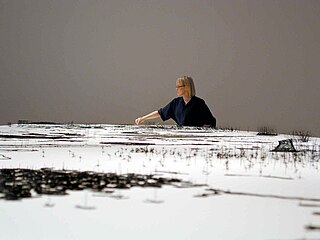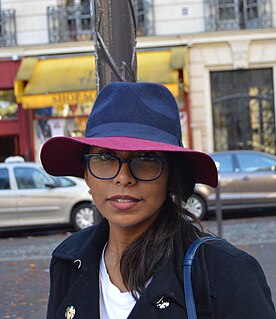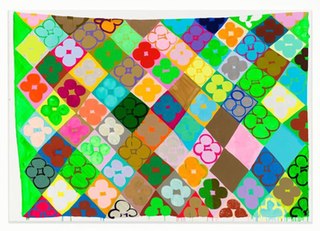
José Bernal Romero was a Cuban-American artist, born in Santa Clara, Cuba, in the former province of Las Villas. He became a naturalized U.S. citizen in 1980.

Anne Wilson is a Chicago-based visual artist. Wilson creates sculpture, drawings, Internet projects, photography, performance, and DVD stop motion animations employing table linens, bed sheets, human hair, lace, thread and wire. Her work extends the traditional processes of fiber art to other media. Wilson is a professor in the Department of Fiber and Material Studies at The School of the Art Institute of Chicago.
Stephen Lapthisophon is an American artist and educator working in the field of conceptual art, critical theory, and disability studies.
Kaya Oakes is an American nonfiction writer and journalist from the San Francisco Bay Area of California.
Saya Woolfalk is an American artist known for her multimedia exploration of hybridity, science, race and sex. Woolfalk uses science fiction and fantasy to reimagine the world in multiple dimensions.

Phyllis Bramson is an American artist, based in Chicago and known for "richly ornamental, excessive and decadent" paintings described as walking a tightrope between "edginess and eroticism." She combines eclectic influences, such as kitsch culture, Rococo art and Orientalism, in juxtapositions of fantastical figures, decorative patterns and objects, and pastoral landscapes that affirm the pleasures and follies of romantic desire, imagination and looking. Bramson shares tendencies with the Chicago Imagists and broader Chicago tradition of surreal representation in her use of expressionist figuration, vernacular culture, bright color, and sexual imagery. Curator Lynne Warren wrote of her 30-year retrospective at the Chicago Cultural Center, "Bramson passionately paints from her center, so uniquely shaped in her formative years […] her lovely colors, fluttery, vignette compositions, and flowery and cartoony imagery create works that are really like no one else's. Writer Miranda McClintic said that Bramson's works "incorporate the passionate complexity of eastern mythology, the sexual innuendos of soap operas and sometimes the happy endings of cartoons." Bramson's work has been exhibited in exhibitions and surveys at the Museum of Contemporary Art, Chicago (MCA), the Art Institute of Chicago, the Smithsonian Institution, and Corcoran Gallery of Art. In more than forty one-person exhibitions, she has shown at the New Museum, Fort Wayne Museum of Art, Boulder Art Museum, University of West Virginia Museum, and numerous galleries. She has been widely reviewed and recognized with John S. Guggenheim and Rockefeller foundation grants and the Anonymous Was A Woman Award, among others. She was one of the founding members of the early women's art collaborative Artemisia Gallery and a long-time professor at the School of Art and Design at the University of Illinois at Chicago, until retiring in 2007.
Tiffany Holmes is an American new media artist and educator. She is based in Chicago, Illinois.
Christine Tarkowski (born 1967) is an American sculptor and installation artist. Through her art, she explores the impact of the built environment on the natural environment.

Natalia Anciso is an American Chicana-Tejana contemporary artist and educator. Her artwork focuses primarily on issues involving Identity, especially as it pertains to her experiences growing up along the U.S.-Mexico Border, via visual art and installation art. Her more recent work covers topics related to education, human rights, and social justice, which is informed by her experience as an urban educator in the San Francisco Bay Area. She is a native of the Rio Grande Valley of South Texas and currently lives and works in Oakland, California.
Santa Barraza is an American mixed-media artist and painter who is well known for her colorful, retablo style painting. A Chicana, Barraza pulls inspiration from her own mestiza ancestry and from pre-Columbian art. Barraza is considered to be an important artist in the Chicano art movement. The first scholarly treatment of a Chicana artist is about her and is called Santa Barraza, Artist of the Borderlands, which describes her life and body of work. Barraza's work is collected by the Mexic-Arte Museum, and other museums around the United States and internationally. She currently lives in Kingsville, Texas.
Liz Nielsen is an American photographer based in Brooklyn.

Andrene Kauffman was an American painter and educator who created a mural for the post office mural project in Ida Grove, Iowa. She completed twenty-five murals and seven sculptures throughout Chicago, as part of the art projects for the New Deal's Section of Painting and Sculpture. Later, she completed seventeen ceramic murals for the 3rd Unitarian Church, which was designated as a Chicago Landmark in 1960. In addition to her artwork and exhibitions, Kauffman taught art for forty-one years at various universities in Chicago, Rockford, Illinois and Valparaiso, Indiana.

Helen O'Toole is an Irish-born painter based in the United States, who is known for abstract paintings suggestive of landscape. She has exhibited throughout Ireland and the United States, in Singapore, and at venues including the San Francisco Museum of Modern Art, Portland Art Museum, Chicago Cultural Center, Tacoma Art Museum, and Institute of Contemporary Arts Singapore. Her work has been featured in the journals Artforum, Arts Magazine, New Art Examiner, and Zyzzyva, as well as the Chicago Tribune,The Irish Times, Seattle Post-Intelligencer, and National Public Radio. Art writers frequently discuss the interplay in her work between abstraction, the evocation of otherworldly light, land and space, and a commitment to investigating meaning through a painting process akin to the processes of cultivation and excavation. Artforum critic James Yood wrote, "echoing the often inchoate quality of nature, her paint surges toward mystery and hints at a kind of chiaroscuro of the spirit"; curator Bonnie Laing-Malcomson suggests her "richly colored monumental paintings evoke the moody landscape of her rural Irish homeland, summoning the force of J. M. W. Turner and Mark Rothko." She has been recognized with a Guggenheim Fellowship in Fine Arts, a Contemporary Northwest Art Award, and a Pollock-Krasner Foundation Award (2013), among other awards. O'Toole lives in Seattle, Washington and is Professor of Art and Chair of the Painting and Drawing Program at the University of Washington.

Laurie Hogin is an American artist, known for allegorical paintings of mutant animals and plants that rework the tropes and exacting styles of Neoclassical art in order to critique, parody or call attention to contemporary and historical mythologies, systems of power, and human experience and variety. She has exhibited nationally and internationally, including at the Museum of Contemporary Art Chicago, International Print Center New York, and Contemporary Arts Center Cincinnati. Her work belongs to the art collections of the New York Public Library, MacArthur Foundation, Addison Gallery of American Art, and Illinois State Museum, among others. Critic Donald Kuspit described her work as both painted with "a deceptive, crafty beauty" and "sardonically aggressive" in its use of animal stand-ins to critique humanity; Ann Wiens characterized her "roiling compositions of barely controlled flora and fauna" as "shrewdly employing art historical concepts of beauty for their subversive potential." Hogin is Professor and Chair of the Studio Art Program at the University of Illinois at Urbana–Champaign.
Meredith Pardue is an American abstract painter.
Carolyn Mims Lawrence is a visual artist and teacher known for her role in the Chicago Black Arts Movement. She earned a BFA from the University of Texas at Austin and a master’s degree in 1968 from the Illinois Institute of Technology with a thesis entitled “Teaching Afro-American Culture through the Visual Arts.” In 1967 Lawrence joined OBAC to create the Wall of Respect, a mural composed of portraits of African American heroes located on the South Side of Chicago. Lawrence collaborated with muralist William Walker to paint the section of the wall honoring Black Muslims.
Suzy González is an American artist and activist, she is known for her paintings and zines that explore social and political issues. She is part of the artist/art curation duo, Dos Mestizx, along with artist Michael Menchaca.

Judy Ledgerwood is an American abstract painter and educator, who has been based in Chicago. Her work confronts fundamental, historical and contemporary issues in abstract painting within a largely high-modernist vocabulary that she often complicates and subverts. Ledgerwood stages traditionally feminine-coded elements—cosmetic and décor-related colors, references to ornamental and craft traditions—on a scale associated with so-called "heroic" abstraction; critics suggest her work enacts an upending or "domestication" of modernist male authority that opens the tradition to allusions to female sexuality, design, glamour and pop culture. Critic John Yau writes, "In Ledgerwood’s paintings the viewer encounters elements of humor, instances of surprise, celebrations of female sexuality, forms of vulgar tactility, and intense and unpredictable combinations of color. There is nothing formulaic about her approach." Ledgerwood has exhibited widely at galleries throughout the United States and in Europe and at institutions including the Art Institute of Chicago, Museum of Contemporary Art Chicago, Smart Museum of Art, and Renaissance Society. Her work belongs to the public art collections of the Metropolitan Museum of Art, Museum of Contemporary Art, Los Angeles, Art Institute of Chicago, and Museum of Contemporary Art Chicago, among others; a monograph, Judy Ledgerwood, was published in 2009 by Hatje Cantz. Ledgerwood lives and works in the Chicago area with her husband, artist Tony Tasset, and teaches at Northwestern University.

Eliza Myrie is a visual artist who lives and works in Chicago, IL. Myrie works in a variety of media including sculpture, participatory installation art, public art, and printmaking.
Connie Arismendi is a Chicana visual artist who works primarily in sculpture and mixed media installations.








